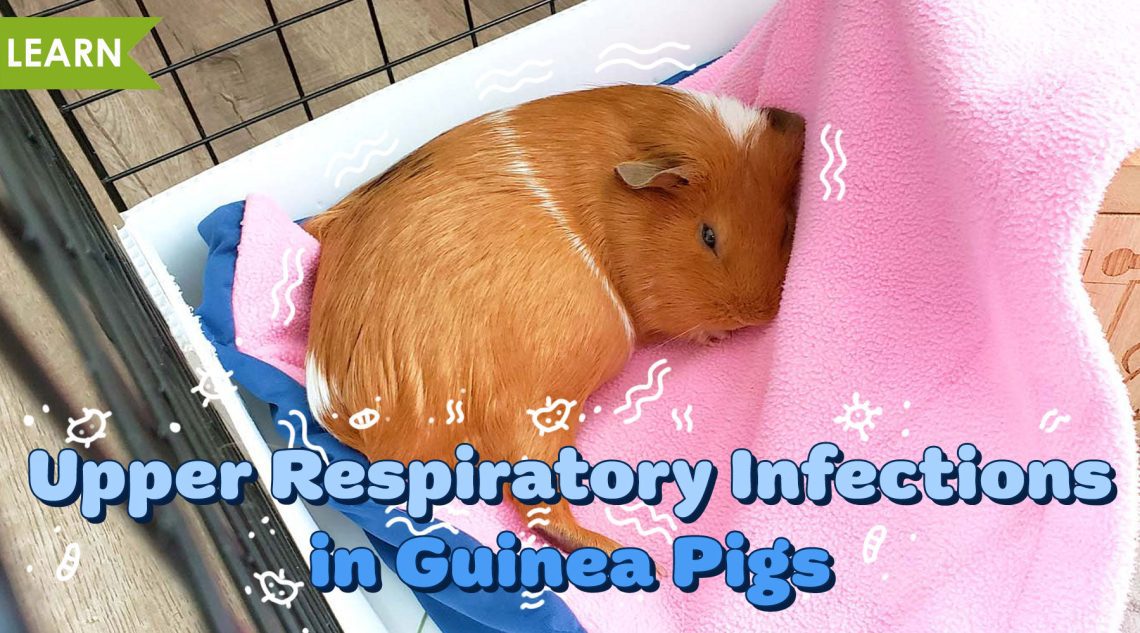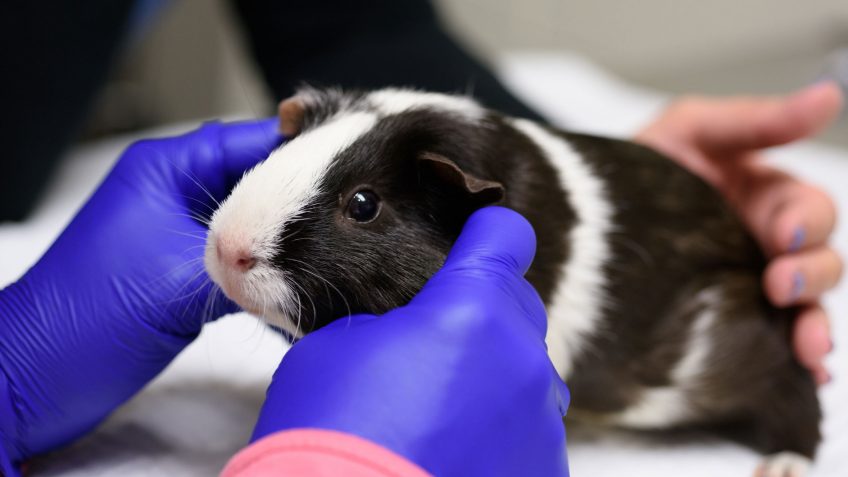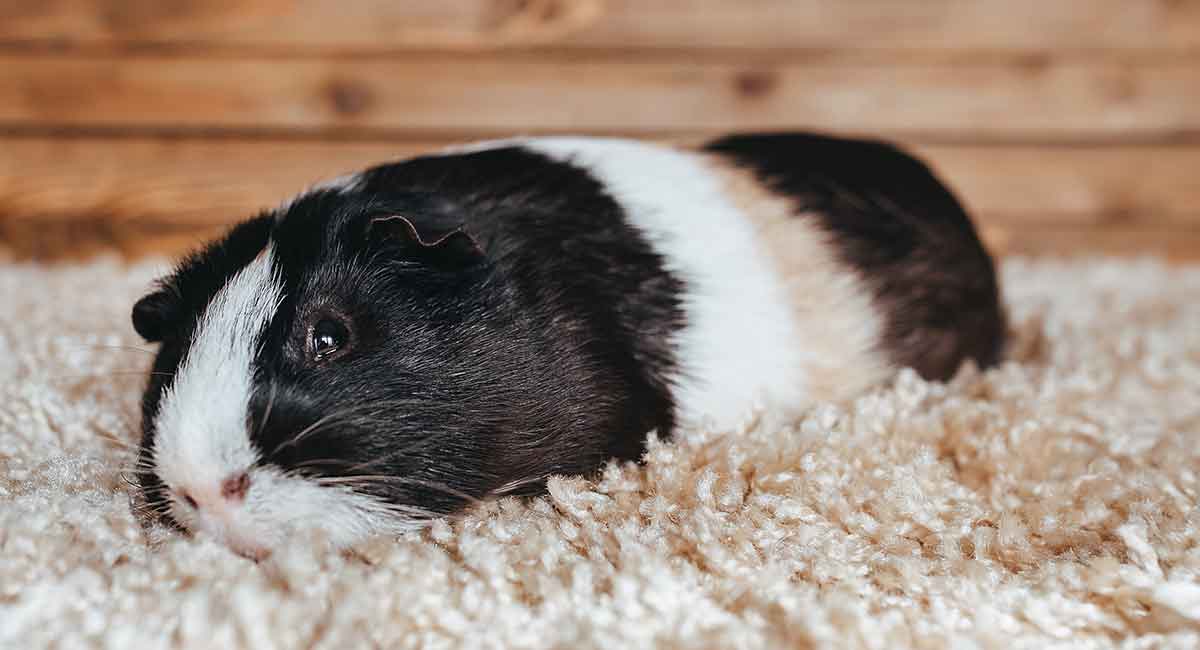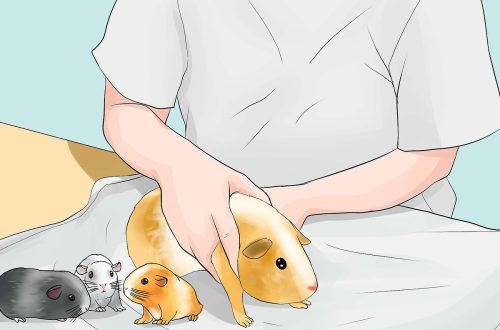
Respiratory diseases in guinea pigs
Respiratory diseases (inflammation of the upper respiratory tract and lungs) in guinea pigs are quite common. The respiratory organs, like the digestive organs, are a weak point in pigs.
The physiological respiratory rate is 100-150 breaths per minute.
The most common causes of respiratory diseases are:
- “cold” caused by the mumps getting cold or being exposed to a draft
- infection.
Guinea pigs are sensitive to cold, so being cold can often be a trigger for upper respiratory tract infections or worse, pneumonia. Pay special attention to the location of your guinea pig’s cage. Keep her away from drafts, open doors and open windows.
Symptoms of respiratory diseases in guinea pigs:
- general weakness, lethargy,
- increase in body temperature,
- rapid labored breathing,
- sneezing,
- cough (not always)
- wheezing (not always)
- discharge from the nose and eyes
- increased thirst and decreased appetite,
- pigs lie more, react poorly to the nickname and external irritations.
Treatment of respiratory diseases in guinea pigs: first of all, you need to create good conditions for the animal; sulfa drugs are used for therapeutic purposes.
Respiratory diseases (inflammation of the upper respiratory tract and lungs) in guinea pigs are quite common. The respiratory organs, like the digestive organs, are a weak point in pigs.
The physiological respiratory rate is 100-150 breaths per minute.
The most common causes of respiratory diseases are:
- “cold” caused by the mumps getting cold or being exposed to a draft
- infection.
Guinea pigs are sensitive to cold, so being cold can often be a trigger for upper respiratory tract infections or worse, pneumonia. Pay special attention to the location of your guinea pig’s cage. Keep her away from drafts, open doors and open windows.
Symptoms of respiratory diseases in guinea pigs:
- general weakness, lethargy,
- increase in body temperature,
- rapid labored breathing,
- sneezing,
- cough (not always)
- wheezing (not always)
- discharge from the nose and eyes
- increased thirst and decreased appetite,
- pigs lie more, react poorly to the nickname and external irritations.
Treatment of respiratory diseases in guinea pigs: first of all, you need to create good conditions for the animal; sulfa drugs are used for therapeutic purposes.

Pneumonia in guinea pigs
Pneumonia is one of the most dangerous diseases in guinea pigs and can be caused by several bacteria, including streptococcus pyogenes, diplococcus pneumoniae, bordetella bronchiseptica, pasteurella multocida.
Guinea pigs can carry these bacteria and show no symptoms of the disease. But in the event of a decrease in immunity, during pregnancy, severe stress or weakening of the body, bacteria begin to multiply uncontrollably, causing illness.
Various types of pneumonia pathogens can be dangerous to humans. Guinea pigs often get infections from humans. As with many infectious diseases, in this case, the development of infection and the severity of the disease can be affected by poor management and poor food.
The infection often affects young animals. The bacteria are spread by direct contact with aerosol (airborne) particles and on contaminated hands or other objects.
Despite the fact that the causative agents of the disease can be different types, the forms of manifestation of the disease are very similar.
Symptoms of pneumonia in guinea pigs:
- refusal of food
- sneezing,
- increase in body temperature,
- runny nose and lacrimation,
- there may be breathing problems.
At the nostrils you can sometimes find purulent discharge from the nose. Breathing is very rapid, superficial. Animals show pleurisy, which the veterinarian can hear by listening. If guinea pigs rub their nose on the floor or try to clear their nose of purulent secretions with their front paws, then this is one of the characteristic symptoms of the disease.
Animals most often get pneumonia with pneumonia in winter, since at this time the amount of green fodder is limited and food contains significantly less nutrients.
To prescribe an effective antibiotic, it is necessary to establish the pathogen, for which the discharge from the eyes and / or nose of the animal is taken for analysis. Some guinea pigs may require hospitalization for additional supportive care.
When keeping several guinea pigs, diseased animals must be immediately isolated. It is not enough just to place sick animals separately. Separate containers for food and drink should be provided for them, and hands should be thoroughly disinfected after contact with sick animals in order to minimize the likelihood of transmission of infection to healthy animals.
The likelihood of recovery from pneumonia in guinea pigs used to be very low, but now with a timely diagnosis and proper treatment, the chances of recovery are much higher. Pneumonia treatment carried out with antibiotics parenterally, so as not to destroy the sensitive intestinal flora.
For prevention of pneumonia in guinea pigs in winter, it is recommended to give gilts germinated cereals or to freeze enough green food during the summer to supplement their winter food. In addition, care must be taken to ensure that the relative humidity in the room does not fall too low during the heating period. A guinea pig, just like a person, likes when the relative humidity of the air is 50%. Too low air humidity favors infection of the respiratory tract. Humidifiers, evaporators, and just a large number of indoor plants keep the humidity in the room above 45% in winter.
Pneumonia is one of the most dangerous diseases in guinea pigs and can be caused by several bacteria, including streptococcus pyogenes, diplococcus pneumoniae, bordetella bronchiseptica, pasteurella multocida.
Guinea pigs can carry these bacteria and show no symptoms of the disease. But in the event of a decrease in immunity, during pregnancy, severe stress or weakening of the body, bacteria begin to multiply uncontrollably, causing illness.
Various types of pneumonia pathogens can be dangerous to humans. Guinea pigs often get infections from humans. As with many infectious diseases, in this case, the development of infection and the severity of the disease can be affected by poor management and poor food.
The infection often affects young animals. The bacteria are spread by direct contact with aerosol (airborne) particles and on contaminated hands or other objects.
Despite the fact that the causative agents of the disease can be different types, the forms of manifestation of the disease are very similar.
Symptoms of pneumonia in guinea pigs:
- refusal of food
- sneezing,
- increase in body temperature,
- runny nose and lacrimation,
- there may be breathing problems.
At the nostrils you can sometimes find purulent discharge from the nose. Breathing is very rapid, superficial. Animals show pleurisy, which the veterinarian can hear by listening. If guinea pigs rub their nose on the floor or try to clear their nose of purulent secretions with their front paws, then this is one of the characteristic symptoms of the disease.
Animals most often get pneumonia with pneumonia in winter, since at this time the amount of green fodder is limited and food contains significantly less nutrients.
To prescribe an effective antibiotic, it is necessary to establish the pathogen, for which the discharge from the eyes and / or nose of the animal is taken for analysis. Some guinea pigs may require hospitalization for additional supportive care.
When keeping several guinea pigs, diseased animals must be immediately isolated. It is not enough just to place sick animals separately. Separate containers for food and drink should be provided for them, and hands should be thoroughly disinfected after contact with sick animals in order to minimize the likelihood of transmission of infection to healthy animals.
The likelihood of recovery from pneumonia in guinea pigs used to be very low, but now with a timely diagnosis and proper treatment, the chances of recovery are much higher. Pneumonia treatment carried out with antibiotics parenterally, so as not to destroy the sensitive intestinal flora.
For prevention of pneumonia in guinea pigs in winter, it is recommended to give gilts germinated cereals or to freeze enough green food during the summer to supplement their winter food. In addition, care must be taken to ensure that the relative humidity in the room does not fall too low during the heating period. A guinea pig, just like a person, likes when the relative humidity of the air is 50%. Too low air humidity favors infection of the respiratory tract. Humidifiers, evaporators, and just a large number of indoor plants keep the humidity in the room above 45% in winter.

Lymphocytic choriomeningitis in guinea pigs
Lymphocytic choriomeningitis in guinea pigs can only be diagnosed using medical equipment. This infection is transmitted to people in an acute form. The disease causes fatal meningoencephalitis.
The source is often infected house mice. In guinea pigs, the disease can be asymptomatic or with severe difficulty breathing and pneumonia, as well as pleurisy. Strong breath sounds can be heard on auscultation.
In view of the great danger to humans, the treatment of this disease is out of the question. If lymphocytic choriomeningitis is suspected, the guinea pig is euthanized. In each case, an autopsy should be performed to identify the causative agents of the disease.
Lymphocytic choriomeningitis in guinea pigs can only be diagnosed using medical equipment. This infection is transmitted to people in an acute form. The disease causes fatal meningoencephalitis.
The source is often infected house mice. In guinea pigs, the disease can be asymptomatic or with severe difficulty breathing and pneumonia, as well as pleurisy. Strong breath sounds can be heard on auscultation.
In view of the great danger to humans, the treatment of this disease is out of the question. If lymphocytic choriomeningitis is suspected, the guinea pig is euthanized. In each case, an autopsy should be performed to identify the causative agents of the disease.





